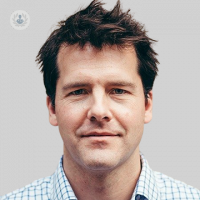Adenoid surgery for children: What to expect
Written by:The adenoids are lumps of lymphoid tissue that sit at the back of the nose. They are present in childhood, but in most cases disappear by adulthood. They are part of the immune system and play a role in fighting infections, but sometimes they can cause more harm than good. Mr Julian Hamann, a top paediatric otolaryngologist (ENT surgeon), explains adenoid surgery in children and what parents can expect.

Why would my child need surgery on their adenoids?
There are several reasons why children may need to have their adenoids removed:
- If the adenoids are very large, they can block the nose, forcing children to breathe through their mouths. This can cause problems with eating and sleeping.
- Large adenoids are a common cause of snoring in children. In severe cases, they can cause the airways to become temporarily blocked, causing breathing to stop for several seconds (a condition called obstructive sleep apnoea).
- The adenoids sit in between the tubes that drain the ears (Eustachian tubes). Removing the adenoids reduces the likelihood of future problems with hearing loss caused by mucus on the inside of the eardrums (i.e. glue ear), and ear infections on the inside of the eardrum (e.g. acute otitis media).
- Sometimes infected adenoids can give rise to sinus infections.
How can I help them prepare for the surgery?
Ideally, children should be in a relaxed state of mind for surgery. This not only helps the child, but also the family and medical staff. Reassure your child that they will feel better after their operation, and they will be able to eat foods like ice cream and yoghurt. Adenoid surgery is not usually painful and is ordinarily performed as a day case procedure.
Certain medicines can cause problems with anaesthetic medication, or increase the risk of bleeding. Therefore, it is important that you let the hospital staff know if your child is taking any regular medicines (tablets, creams, sprays or infusions).
If your child is unwell in the run-up to surgery, it's important to let your doctor know. In most cases, it is best to perform surgery when your child is well.
Check with the hospital when your child can eat or drink before surgery. In most cases, children should not have anything to eat for six hours before surgery. It is sometimes acceptable for children to drink water until two hours before surgery, although this practice varies from hospital to hospital.
What happens during the procedure?
A parent will usually accompany their child to the anaesthetic room, and stay with them until he or she is asleep. The child is then taken into the operating room. The adenoids are usually removed via the mouth, which is held open by a splint whilst the operation is performed. There are several methods by which the adenoids can be removed. They can be scraped, cauterised or dissolved away, using different instruments. The breathing tube is then removed from the child's mouth, and they are taken to the recovery room. A parent is usually invited down to the recovery room as soon as the child has woken up.
What are the risks involved?
Adenoidectomy is usually a low-risk surgery. Very occasionally (one in several hundred procedures), heavy bleeding can occur, requiring a second trip to the operating theatre to stop it. This usually occurs within hours of surgery.
Occasionally, infections can occur, which can give rise to a blocked nose, discharge or bad breath. One in several hundred children will have problems with liquid going into the back of the nose when they swallow (nasal regurgitation), although this is usually a temporary problem. Very occasionally, a tooth can be chipped or a lip grazed from either the surgeon or anaesthetist putting instruments into the child's mouth. General anaesthesia is usually very safe in children, although rarely problems can occur.
Will they need to stay in hospital?
In the majority of cases, children do not need to stay in hospital, and can usually go home several hours of following the procedure.
What symptoms should I watch out for afterwards?
Children will usually have a slightly sore throat following adenoidectomy and sometimes they will have a stiff jaw. Some children will have an earache, and some will have a nasal sounding voice. It's normal for the nose to be blocked for a week or two following surgery. It is also common for children to continue to snore for this period of time. Children will often have slightly bad breath for a week or so whilst the back of the nose heals.
If your child becomes unwell, has a temperature, foul-smelling discharge from the nose, bleeding or significant pain you should contact your doctor or go to your nearest accident and emergency department.
If you'd like expert attention regarding adenoid surgery, arrange a consultation with Mr Hamann via his Top Doctors profile.


